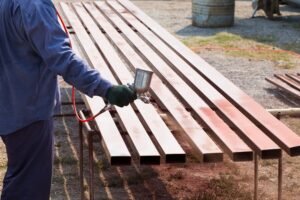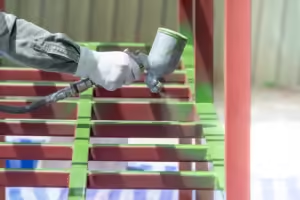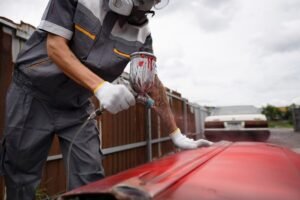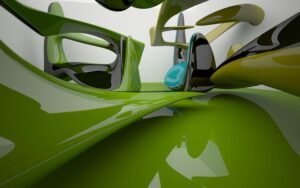Introduction to Essential Anti-Corrosion Coatings
Anti-corrosion coatings are specialized formulations designed to protect surfaces from the detrimental effects of corrosion. These coatings act as a barrier between the substrate and the corrosive environment, effectively mitigating chemical reactions that lead to rust and degradation. Corrosion can occur in various forms, including uniform corrosion, galvanic corrosion, and pitting corrosion, each presenting unique challenges across multiple industries such as construction, marine, automotive, and manufacturing.
The importance of anti-corrosion coatings cannot be overstated. In sectors where materials are subjected to harsh environmental conditions, such as exposure to moisture, salt, or chemicals, the application of these coatings can significantly extend the life of assets. This is particularly crucial in industries relying on metal components, where the costs associated with corrosion can be exorbitant. It is estimated that corrosion costs industries billions of dollars annually in repairs, replacements, and loss of production—a stark reminder of the economic implications of neglecting protective measures.
Protective coatings come in various types, including organic coatings, inorganic coatings, and metallic coatings, each offering varying levels of protection depending on the specific application. Organic coatings, such as paints and polymers, provide good adhesion and flexibility, making them suitable for a range of surfaces. In contrast, metallic coatings, such as galvanization, involve the application of a metal layer, often zinc, which sacrificially protects underlying metals from corrosion. Furthermore, advancements in technology have led to the development of sophisticated anti-corrosion solutions that combine multiple protective properties, enhancing their effectiveness.
In summary, the strategic deployment of anti-corrosion coatings is essential for safeguarding investments across diverse industries. By understanding the types of corrosion and the protective options available, businesses can effectively mitigate risks, ensuring longevity and reliability in their assets.

Types of Anti-Corrosion Coatings
Anti-corrosion coatings are essential in preventing corrosion and extending the life of various assets, particularly in industries such as marine, construction, and manufacturing. There are two primary categories of anti-corrosion coatings: organic and inorganic coatings, each with distinct compositions and properties.
Organic coatings typically comprise polymers and resins, which provide robust protection against corrosion. These coatings are known for their flexibility and adhesion properties, making them suitable for various substrates. Common types of organic coatings include epoxy, polyurethane, and alkyd-based products. Epoxy coatings, in particular, are favored for their strong bonding abilities and chemical resistance, often utilized in industrial environments where heavy machinery and equipment are subjected to harsh conditions. Additionally, polyurethane coatings are recognized for their superior durability and UV resistance, which makes them ideal for outdoor applications.
On the other hand, inorganic coatings derive their protective qualities from metal compounds. These coatings, such as zinc-rich and silicate-based options, offer substantial resistance to high temperatures and harsh environments. Zinc-rich coatings are particularly effective due to their sacrificial properties, meaning that zinc particles corrode preferentially, thus protecting the underlying substrate. Silicate-based coatings, noted for their excellent adhesion and impact resistance, are frequently employed in high-temperature applications and aggressive industrial settings.
When selecting a coating, it is crucial to consider the environmental conditions to which the asset will be exposed, including factors such as humidity, temperature fluctuations, and potential chemical contact. The effectiveness of each type of anti-corrosion coating can vary depending on these conditions. Therefore, understanding the attributes of organic and inorganic coatings is vital for ensuring optimal protection against corrosion, effectively safeguarding critical assets.


Key Components of Anti-Corrosion Coatings
Anti-corrosion coatings are essential for protecting various assets from the detrimental effects of environmental factors, particularly moisture and corrosive agents. The effectiveness of these coatings heavily relies on several key components: binders, pigments, solvents, and additives. Each component plays a vital role in ensuring the durability and performance of the coating.
Binders serve as the primary structure of anti-corrosion coatings. They are typically made from polymers that establish adhesion between the substrate and the coating itself. The quality of the binder directly influences the coating’s flexibility, hardness, and resistance to weathering. For instance, epoxy resins are commonly used for their exceptional bonding capabilities and chemical resistance, particularly in industrial applications where long-lasting protection is paramount.
Pigments contribute not only to the aesthetic appeal of the coating but also to its protective features. Certain pigments are effective in blocking ultraviolet radiation, which can lead to degradation of the underlying materials. Others may contain corrosion-inhibiting properties, which further enhance the protective nature of the anti-corrosion coating. By integrating high-performance pigments, manufacturers ensure that the aesthetics do not compromise functionality.
Solvents play a crucial role in facilitating the application of the coatings. They dissolve the binder and pigments, allowing for a uniform application on various surfaces. The choice of solvent impacts the drying time and the overall performance of the coating. Appropriate solvent selection is critical to achieve optimal viscosity, ensuring that the anti-corrosion coat adheres well and forms a durable layer.
Finally, additives are incorporated to enhance the performance attributes of the coatings. These may include anti-foaming agents, drying accelerators, or permeability reducers, contributing to the coatings’ overall effectiveness. The meticulous formulation of these components ensures that anti-corrosion coatings deliver the long-lasting protection necessary for assets exposed to harsh environments.
Application Techniques for Anti-Corrosion Coatings
Anti-corrosion coatings play a crucial role in preserving the integrity and longevity of various assets. An effective application technique is essential for ensuring that these coatings perform as intended. Among the most commonly used methods for applying anti-corrosion coatings are brush, roller, and spray techniques, each offering distinct advantages depending on the requirements of the project.
The brush application technique is often favored for its precision, particularly in cases where detailed work or touch-ups are necessary. It allows for greater control when applying the coating to intricate surfaces or hard-to-reach areas. However, achieving a uniform thickness may require additional effort, as it can sometimes lead to over-brushing or uneven application. Additionally, the speed of application may be a factor in larger projects.
Roller application, on the other hand, is ideal for larger, flat surfaces, as it can significantly reduce application time. This method allows for a more consistent coat and can cover expansive areas quickly. It is important to select the appropriate roller nap to ensure proper coating thickness and reduce the likelihood of air bubbles forming. Regardless of the method chosen, surface preparation is critical. Surfaces should be free from dust, grease, and existing corrosion to promote adhesion and improve the overall performance of the anti-corrosion coatings.
Spray application offers the fastest and most versatile method of coating large areas, particularly for complex geometries and structures. This technique can achieve a smooth finish and is often utilized for industrial applications. However, careful attention must be paid to environmental conditions, as factors such as temperature, humidity, and wind can affect the application process and subsequently the performance of the coating. Ensuring optimal conditions leads to better adhesion and curing, ultimately protecting the assets more effectively.
Testing and Performance Evaluation
To ensure the effectiveness of anti-corrosion coatings, testing and performance evaluation are critical steps in the application process. Various standard tests are employed to assess key properties such as adhesion, flexibility, and resistance to environmental factors. These tests provide valuable insights into how well these coatings can protect surfaces from corrosion.
Adhesion tests are essential in evaluating how well the coating bonds to the substrate. The most commonly used method is the pull-off test, where a loading apparatus is attached to the surface, and force is applied until the coating separates from the substrate. A higher adhesion strength signifies a more reliable protective layer, which is imperative for anti-corrosion coatings. Moreover, flexibility tests examine the coating’s ability to deform without cracking. The bend test, where a coated panel is bent at a specified angle, can reveal a coating’s capacity to endure structural movements, thereby enhancing its longevity.
Resistance to environmental factors such as humidity, temperature fluctuations, and corrosive substances is another critical area of evaluation. Salt spray tests simulate harsh conditions, enabling evaluators to determine how well coatings resist oxidation and deterioration over time. Furthermore, examining the performance in various climates and environments provides insights into the durability of the coating under real-world conditions.
Interpreting the results from these tests plays an essential role in determining the appropriate application of anti-corrosion coatings. A well-chosen coating based on test results can significantly enhance asset longevity, making it vital for industries dependent on protective films for infrastructure and machinery. Ultimately, rigorous testing ensures that the chosen anti-corrosion paint, among others, meets quality standards and delivers the protection required for long-term asset management.
Industry-Specific Applications
Anti-corrosion coatings serve a pivotal role across numerous industries, providing essential protection for assets exposed to harsh environments. One significant sector that benefits from these coatings is the construction industry. For example, structural steel used in skyscraper projects requires robust anti-corrosion treatment to withstand moisture and other environmental factors. Case studies have illustrated the effectiveness of these coatings in extending the lifespan of steel structures, reducing maintenance costs significantly.
Another vital industry is automotive manufacturing, where corrosion can lead to structural weaknesses and aesthetic deterioration. The use of anti-corrosion coatings on vehicle exteriors and undercarriages protects against road salt, moisture, and other harsh elements. A notable case study encompasses a major automotive company that implemented advanced anti-corrosion solutions, leading to a marked increase in product durability and a decrease in warranty claims related to corrosion damage.
Marine applications also heavily rely on anti-corrosion coatings due to the highly corrosive nature of saltwater. Ships, boats, and offshore rigs are all susceptible to deterioration without appropriate protection. An illustrative example includes a prominent shipping company that adopted specialized coatings for their vessel hulls, which resulted in extended maintenance intervals and improved operational efficiency by minimizing downtime due to repairs.
The oil and gas industry faces unique challenges with equipment and pipelines that are consistently exposed to extreme conditions. Anti-corrosion coatings have proven to be invaluable in these environments. For instance, a specific oil pipeline project utilized advanced coatings that significantly reduced corrosion rates, showcasing substantial long-term savings and enhanced safety standards.
Overall, the implementation of anti-corrosion coatings across various industries not only protects assets but also offers substantial financial benefits by reducing maintenance and replacement costs. As organizations continue to prioritize asset preservation, investing in effective coatings remains a strategic decision.
Challenges and Innovations in Anti-Corrosion Coatings
The production and application of anti-corrosion coatings present a variety of challenges that must be navigated to ensure effective asset protection. One significant challenge is adhering to stringent environmental regulations that govern the use of volatile organic compounds (VOCs). These regulations aim to reduce air pollution and protect public health, leading manufacturers to seek alternative formulations that comply without sacrificing performance. The demand for sustainability has become critical, prompting companies to innovate and adapt their processes while still delivering reliable anti-corrosion solutions.
In response to these challenges, the industry has seen a shift towards eco-friendly formulations. This trend is evident in the development of water-based coatings, which have lower VOC levels compared to traditional solvent-based options. Additionally, bio-based materials are gaining traction, as they utilize renewable resources, thus minimizing the environmental footprint associated with the production of anti-corrosion coatings. These advancements not only adhere to regulatory requirements but also align with the growing consumer demand for sustainable practices.
Furthermore, new technological innovations are enhancing the performance of anti-corrosion coatings. For instance, smart coatings that provide real-time monitoring of corrosion levels are being developed. These intelligent solutions employ sensors embedded within the coating to detect changes in the environment, allowing for timely maintenance decisions and improved asset longevity. The integration of advanced materials, such as nanotechnology, is also revolutionizing the industry by enhancing the durability and effectiveness of anti-corrosion coatings while often reducing the amount needed for application.
In conclusion, the challenges surrounding anti-corrosion coatings require innovative approaches to meet both environmental and performance standards. The industry’s shift towards sustainability and the adoption of advanced technologies signify a promising future for effective and eco-friendly anti-corrosion solutions, ultimately contributing to the protection of valuable assets.
Maintenance and Lifespan of Anti-Corrosion Coatings
Anti-corrosion coatings play a crucial role in protecting assets from the damaging effects of environmental elements, but their effectiveness hinges significantly on proper maintenance and timely inspections. To maximize the lifespan of these protective layers, several best practices should be implemented. Regular upkeep not only extends the longevity of the coatings but also ensures they function at their optimal capacity.
One of the primary factors influencing the lifespan of anti-corrosion coatings is the environment in which they are applied. Harsh conditions—such as exposure to moisture, chemicals, and extreme temperature fluctuations—can expedite wear and tear. Conducting routine inspections, ideally every six months to a year, allows for early detection of any degradation. When inspecting, particular emphasis should be placed on areas prone to corrosion, such as seams, joints, and edges. Any signs of deterioration, such as peeling, blistering, or discoloration, should be addressed immediately to prevent further damage.

Moreover, the application of the anti-corrosion coating is critical. Ensuring the surface is adequately prepared before application can significantly affect the durability of the coating. Additionally, following the manufacturer’s guidelines regarding application methods, ambient conditions, and recommended maintenance practices is essential for achieving the desired protection levels. Regular cleaning of the coated surfaces helps in maintaining the integrity of anti-corrosion coatings. Remove dirt, debris, and any corrosive substances that may accumulate over time. This proactive approach bolsters the overall performance of the coatings, often extending their functional lifespan.
By prioritizing maintenance, adhering to environmental considerations, and performing regular inspections, the longevity and effectiveness of anti-corrosion coatings can be significantly enhanced. These steps are essential in maximizing the investment in protective coatings and ensuring that assets are safeguarded against corrosion-related damages.
Conclusion: The Future of Anti-Corrosion Coatings
The significance of anti-corrosion coatings cannot be overstated in a world where infrastructure and equipment maintenance is paramount for longevity and performance. These coatings serve not only to enhance the aesthetic appeal of surfaces but also to provide a protective barrier against the corrosive elements that can lead to deterioration over time. With industries relying heavily on various materials, the necessity for effective solutions like anti-corrosion coatings becomes increasingly apparent. As such, advancements in this domain are essential for safeguarding assets across numerous sectors, including transportation, construction, and manufacturing.
Looking towards the future, ongoing research and technology developments in anti-corrosion coatings are likely to yield significant breakthroughs. Emerging materials that offer better performance, combined with innovative application techniques, may lead to enhanced durability and efficiency. For instance, the integration of nanotechnology into coating formulations could provide superior protection, ensuring that surfaces remain intact for prolonged periods. Furthermore, the potential development of self-healing coatings presents an exciting frontier in mitigating corrosion damage, transforming how industries approach surface protection.

Moreover, environmental considerations are expected to play a crucial role in shaping the future of anti-corrosion solutions. The push for sustainable practices is likely to drive the development of eco-friendly coatings that do not compromise on effectiveness. Manufacturers may increasingly invest in research to create paints and coatings that are not only more effective in preventing corrosion but also less harmful to the environment. As trends towards sustainability gain momentum, the innovations within this area will be paramount in meeting regulatory standards and societal expectations.
In conclusion, the evolution of anti-corrosion coatings appears poised for rapid advancement, driven by technological, environmental, and economic factors. As industries lean towards more resilient and sustainable solutions, the continuous enhancement of protective technologies will undoubtedly play a critical role in ensuring the longevity of assets in an increasingly corrosive world.
